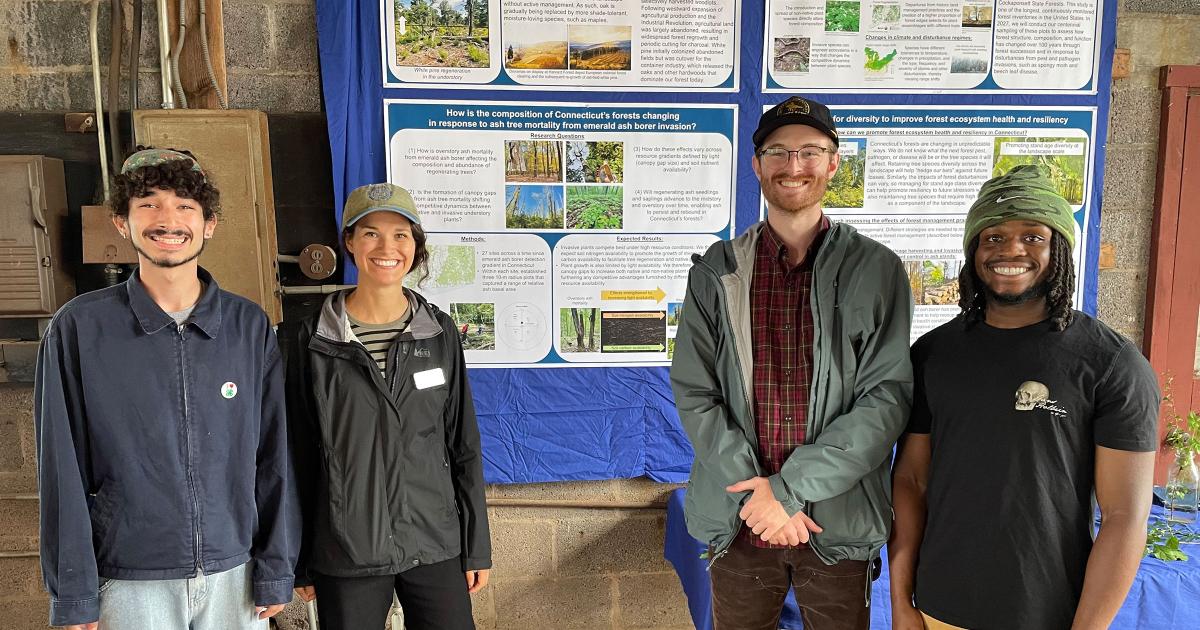New Haven Promise Interns Learn in the Field
When Xavier Murrell began his New Haven Promise (NHP) summer internship at the Yale School of the Environment, he didn’t have much forestry experience. It didn’t take long though, before he was able to contribute to field research on the impact of invasive insects on forests.
“I enjoyed it a lot,” said Murrell, a University of Connecticut animal science major. “I learned to identify plant and tree species by their bark and the shape of their leaves. I encountered a lot of things in the woods I never would have noticed before my internship.”
Murrell was one of four students from Connecticut universities who completed summer internships through New Haven Promise, a program that supports paid internships to help students gain work experience in their respective fields of study. The program also awards Yale-funded tuition scholarships to local students attending Connecticut public colleges and universities and provides up to $2,500 toward tuition to New Haven students attending private universities in the state. YSE faculty and graduate students have mentored NHP interns each summer since 2014.
I think the most wonderful part is that students are exposed to careers they may never have considered.”
“I think the most wonderful part is that students are exposed to careers they may never have considered,” said Annise Dobson, director of research programs and associate research scientist, who has recruited NHP interns for several of her research projects. “Maybe you’ve never considered becoming an urban forester or studying climate change through soils. You need to be able to explore your options to know those kinds of jobs exist.”
University of Connecticut students Kaleb Diaz Alvarez and Levi Ariker and Yale College student Young In Kim also completed internships at YSE this summer.
The aftermath of the emerald ash borer
Alvarez, an ecology and evolutionary biology major, worked with Murrell in collecting data for a research project led by Jack Hatajik ’25 MFS on the emerald ash borer, an invasive beetle from Asia that kills ash trees by eating their inner bark. Hatajik and Elisabeth Ward ’18 MFS, ’23 PhD, a forest ecosystem ecologist at the Connecticut Agricultural Experiment Station, are investigating how the beetle is transforming Connecticut forests.
Alvarez and Murrell traveled to Yale-Myers Forest, Sleeping Giant State Park, Naugatuck State Forest, and other areas affected by the ash borer and catalogued plants species growing in forest plots and collected data on the plants that are thriving in the gaps left behind by dead ashes.
“Learning about different plants and having a close connection to the environment are big passions for me, so I feel invested in finding out what’s happening with the forests,” Alvarez said.
Murrell and Alvarez worked under the direction of Marlyse Duguid, Thomas J. Siccama Senior Lecturer in Field Ecology, and director of research at Yale Forests.
“You need a team of students for forestry fieldwork because it’s so intensive,” Duguid said. “Murrell and Alvarez were a huge help, and overseeing undergraduate researchers helps teach YSE graduate students to act as mentors and take ownership of their projects.”
Investigating natural carbon capture
Kim, an environmental studies major and environmentalist with the New Haven Climate Movement, helped postdoctoral associate Fengchao Sun collect data on the capacity of a powdered form of basalt to capture atmospheric carbon as part of Sun’s research on natural climate change mitigation strategies. Kim tested groundwater and stream chemistry at Sun’s research sites in Vermont to determine how much carbon the basalt captures when it is spread on fields and how it affects water quality.
“I’ve learned so much from Fengchao,” Kim said. “I wasn’t that familiar with the scientific side of carbon capture, and she’s been a great mentor.”
Ariker, an animal science major at the University of Connecticut, also focused on natural climate solutions. He worked with Maya Almaraz, an associate research scientist at the Yale Center for Natural Carbon Capture, examining the effects of adding limestone to agricultural fields to enhance carbon capture and promote soil health.
Ariker created an open-access database of scientific literature detailing nearly 2,000 data points on agricultural liming and nitrogen cycling.
“I’ve always felt overwhelmed by scientific literature,” Ariker said. “I’ll be doing research next fall, and this was a good foray into learning to assess a scientific paper’s relevance and extract the data I need.”













